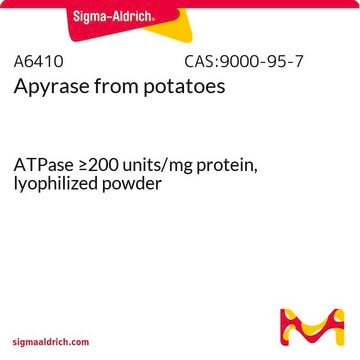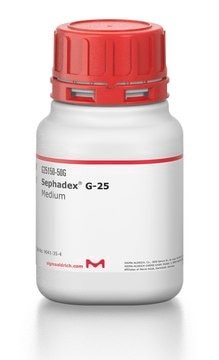A265
ARL 67156 trisodium salt hydrate
≥98% (HPLC), solid, ecto-ATPase inhibitor
Sinónimos:
6-N,N-Diethyl-β-γ-dibromomethylene-D-adenosine-5′-triphosphate trisodium salt hydrate, FPL 67156
About This Item
Productos recomendados
product name
ARL 67156 trisodium salt hydrate, ≥98% (HPLC), solid
Quality Level
assay
≥98% (HPLC)
form
solid
color
white to off-white
solubility
H2O: >20 mg/mL
DMSO: insoluble
storage temp.
−20°C
SMILES string
O.[Na+].[Na+].[Na+].CCN(CC)c1ncnc2n(cnc12)[C@@H]3O[C@H](COP(O)(=O)OP([O-])(=O)C(Br)(Br)P([O-])([O-])=O)[C@@H](O)[C@H]3O
InChI
1S/C15H24Br2N5O12P3.3Na.H2O/c1-3-21(4-2)12-9-13(19-6-18-12)22(7-20-9)14-11(24)10(23)8(33-14)5-32-37(30,31)34-36(28,29)15(16,17)35(25,26)27;;;;/h6-8,10-11,14,23-24H,3-5H2,1-2H3,(H,28,29)(H,30,31)(H2,25,26,27);;;;1H2/q;3*+1;/p-3/t8-,10-,11-,14-;;;;/m1..../s1
InChI key
UWMONIJVKGTUGE-OPKBHZIBSA-K
Gene Information
human ... ENTPD2(954)
General description
Application
- to prevent ATP degradation during cerebrospinal fluid extraction
- as an ATPase inhibitor in ATP quantification assay for preventing ATP degradation in cytoplasm and mitochondrion
- as an ecto-ATPase inhibitor to treat cancer cells for ATP release assay
Biochem/physiol Actions
Storage Class
11 - Combustible Solids
wgk_germany
WGK 3
Certificados de análisis (COA)
Busque Certificados de análisis (COA) introduciendo el número de lote del producto. Los números de lote se encuentran en la etiqueta del producto después de las palabras «Lot» o «Batch»
¿Ya tiene este producto?
Encuentre la documentación para los productos que ha comprado recientemente en la Biblioteca de documentos.
Los clientes también vieron
Nuestro equipo de científicos tiene experiencia en todas las áreas de investigación: Ciencias de la vida, Ciencia de los materiales, Síntesis química, Cromatografía, Analítica y muchas otras.
Póngase en contacto con el Servicio técnico













